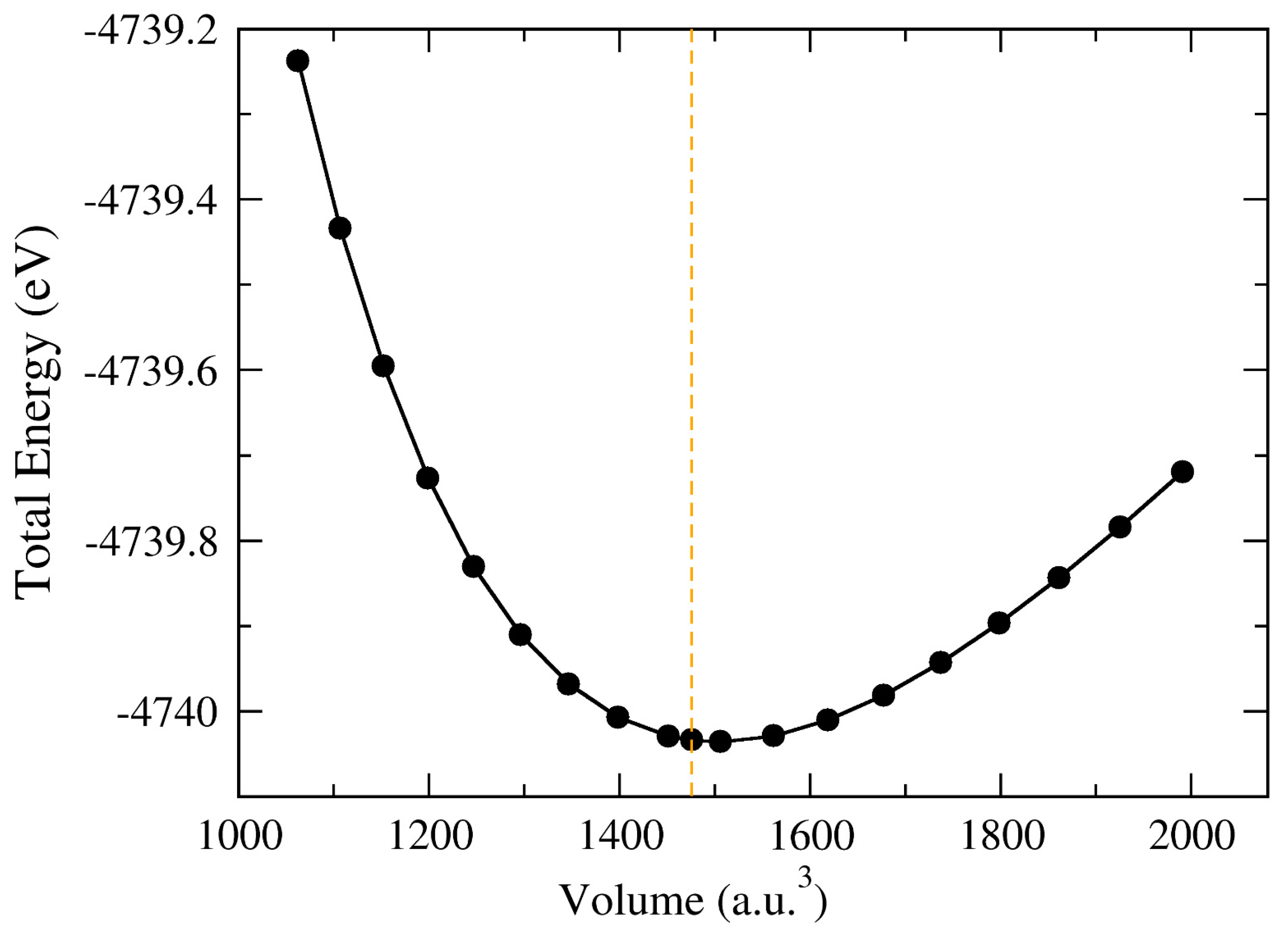Electronic Structure of Intermetallic Antiferromagnet GdNiGe
Abstract
:1. Introduction
2. Computational Method
3. Crystal Structure
4. Results
5. Conclusions
Author Contributions
Funding
Conflicts of Interest
References
- Gupta, S.; Suresh, K.G. Review on magnetic and related properties of RTX compounds. J. Alloys Compd. 2015, 618, 562–606. [Google Scholar] [CrossRef] [Green Version]
- Chen, J.; Shen, B.G.; Dong, Q.Y.; Sun, J.R. Giant magnetic entropy change in antiferromagnetic DyCuSi compound. Solid State Commun. 2010, 150, 1429–1431. [Google Scholar] [CrossRef]
- Singh, N.K.; Suresh, K.G.; Nirmala, R.; Nigam, A.K.; Malik, S.K. Effect of magnetic polarons on the magnetic, magnetocaloric, and magnetoresistance properties of the intermetallic compound HoNiAl. J. Appl. Phys. 2007, 101, 093904. [Google Scholar] [CrossRef] [Green Version]
- Kotsanidis, P.A.; Yakinthos, J.K.; Gamari-Seale, E. Susceptibility of the rare earth ternary equiatomic germanides RNiGe (R = Gd, Tb, Dy, Ho, Er, Tm and Y). J. Less-Common Met. 1990, 157, 295–300. [Google Scholar] [CrossRef]
- Garde, C.S.; Ray, J.; Chandra, G.J. Electrical resistivity, thermopower and thermal conductivity studies in RNiGe (R = Gd, Tb, Dy, Er, Ho, Y) systems. J. Alloys Compd. 1993, 201, L5–L8. [Google Scholar] [CrossRef]
- Long, Y.; Fu, H.; Hashimoto, T.; Matsumoto, K.; Onishi, A.; Satoh, T. Heat-capacity of ternary compounds RNiGe (R = Gd, Dy, Er, and Y). J. Appl. Phys. 1995, 78, 7410–7412. [Google Scholar] [CrossRef]
- Anisimov, V.I.; Aryasetiawan, F.; Lichtenstein, A.I. First-principles calculations of the electronic structure and spectra of strongly correlated systems: The LDA+U method. J. Phys. Condens. Matter. 1997, 9, 767–808. [Google Scholar] [CrossRef]
- Giannozzi, P.; Baroni, S.; Bonini, N.; Calandra, M.; Car, R.; Cavazzoni, C.; Ceresoli, D.; Chiarotti, G.L.; Cococcioni, M.; Dabo, I.; et al. QUANTUM ESPRESSO: A modular and open-source software project for quantum simulations of materials. J. Phys. Condens. Matter. 2009, 21, 395502. [Google Scholar] [CrossRef] [PubMed]
- Giannozzi, P.; Andreussi, O.; Brumme, T.; Bunau, O.; Buongiorno Nardelli, M.; Calandra, M.; Car, R.; Cavazzoni, C.; Ceresoli, D.; Cococcioni, M.; et al. Advanced capabilities for materials modelling with Quantum ESPRESSO. J. Phys. Condens. Matter. 2017, 29, 465901. [Google Scholar] [CrossRef] [PubMed] [Green Version]
- Perdew, J.P.; Burke, J.P.; Ernzerhof, M. Generalized Gradient Approximation Made Simple. Phys. Rev. Lett. 1996, 77, 3865–3868. [Google Scholar] [CrossRef] [PubMed] [Green Version]
- Topsakal, M.; Wentzcovitch, R.M. First-principles study of crystal and electronic structure of rare-earth cobaltites. Comput. Mater. Sci. 2014, 95, 263–270. [Google Scholar] [CrossRef]
- Holzwarth, N.A.W.; Tackett, A.R.; Matthews, G.E. A Projector Augmented Wave (PAW) code for electronic structure calculations, Part II: Pwpaw for periodic solids in a plane wave basis. Comput. Phys. Commun. 2001, 135, 329–347. [Google Scholar] [CrossRef]
- Knyazev, Y.V.; Lukoyanov, A.V.; Kuz’min, Y.I.; Gupta, S.; Suresh, K.G. Characterization of d and f Electronic States in RSn1.1Ge0.9 (R = Gd, Tb) Compounds by Optical Spectroscopy and Electronic-Structure Calculations. Phys. Status Solidi B 2018, 255, 1700579. [Google Scholar] [CrossRef]
- Andre, G.; Bouree, F.; Kolenda, M.; Oles, A.; Pacyna, A.; Piiot, M.; Sikora, W.; Slytuta, A. Crystal and magnetic structure of TbNiGe and DyNiGe compounds. J. Magn. Magn. Mater. 1992, 116, 375–385. [Google Scholar] [CrossRef]




| Ion | Point Symmetry | x | y | z |
|---|---|---|---|---|
| Gd | 4c | 0.0212 | 0.25 | 0.6803 |
| Ni | 4c | 0.142 | 0.25 | 0.0609 |
| Ge | 4c | 0.2651 | 0.25 | 0.3771 |
© 2019 by the authors. Licensee MDPI, Basel, Switzerland. This article is an open access article distributed under the terms and conditions of the Creative Commons Attribution (CC BY) license (http://creativecommons.org/licenses/by/4.0/).
Share and Cite
Baglasov, E.D.; Lukoyanov, A.V. Electronic Structure of Intermetallic Antiferromagnet GdNiGe. Symmetry 2019, 11, 737. https://doi.org/10.3390/sym11060737
Baglasov ED, Lukoyanov AV. Electronic Structure of Intermetallic Antiferromagnet GdNiGe. Symmetry. 2019; 11(6):737. https://doi.org/10.3390/sym11060737
Chicago/Turabian StyleBaglasov, Evgenii D., and Alexey V. Lukoyanov. 2019. "Electronic Structure of Intermetallic Antiferromagnet GdNiGe" Symmetry 11, no. 6: 737. https://doi.org/10.3390/sym11060737






